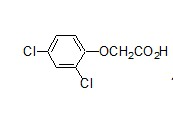Herbicide
2,4D
TC & FORMULATION: 98%TC, 720G/L SL, 860G/L SL
Structure Formula 
NOMENCLATURE
Common name 2,4-D (BSI, E-ISO, (m) F-ISO, WSSA); 2,4-PA (JMAF)
IUPAC name (2,4-dichlorophenoxy)acetic acid
Chemical Abstracts name (2,4-dichlorophenoxy)acetic acid
CAS RN [94-75-7] EEC no. 202-361-1
PHYSICAL CHEMISTRY
2,4-D
Composition Tech. is ³96% pure. Mol. wt. 221.0 M.f. C8H6Cl2O3 Form Colourless powder, with a slight phenolic odour. M.p. 140.5 ºC V.p. 1.86 ´ 10-2 mPa (25 °C, OECD 104) KOW logP = 2.58-2.83 (pH 1), 0.04-0.33 (pH 5) Henry 1.32 ´ 10-5 Pa m3 mol-1 (calc.) S.g./density 1.508 (20 °C) Solubility In water 311 (pH 1), 20 031 (pH 5), 23 180 (pH 7), 34 196 (pH 9) (all in mg/l, 25 °C). In ethanol 1250, diethyl ether 243, heptane 1.1, toluene 6.7, xylene 5.8 (all in g/kg, 20 ºC); in octanol 120 g/l (25 °C). Insoluble in petroleum oils. Mono-n-butylamine salt: In water 18 g/l (30 ºC). Stability 2,4-D is a strong acid, and forms water-soluble salts with alkali metals and amines. Hard water leads to precipitation of the calcium and magnesium salts, but a sequestering agent is included in formulations to prevent this. Photolytic DT50 (simulated sunlight) 7.5 d. pKa 2.73
APPLICATIONS
Biochemistry Synthetic auxin (acting like indolylacetic acid). Mode of action Selective systemic herbicide. Salts are readily absorbed by the roots, whilst esters are readily absorbed by the foliage. Translocation occurs, with accumulation principally at the meristematic regions of shoots and roots. Acts as a growth inhibitor. Uses Post-emergence control of annual and perennial broad-leaved weeds in cereals, maize, sorghum, grassland, established turf, grass seed crops, orchards (pome fruit and stone fruit), cranberries, asparagus, sugar cane, rice, forestry, and on non-crop land (including areas adjacent to water), at 0.28-2.3 kg/ha. Control of broad-leaved aquatic weeds. The isopropyl ester can also be used as a plant growth regulator to prevent premature fruit fall in citrus fruit. Phytotoxicity Phytotoxic to most broad-leaved crops, especially cotton, vines, tomatoes, ornamentals, fruit trees, oilseed rape and beet. Formulation types EC; GR; SP; SL.
About price and product information, please click Message button.
Open the consulting page, please Writing information, customer manager will reply within 24 hours!
or Contact email:Donna.wen@molotuschem.com
Cell-phone number:17717500809
Tel:0086 21 61203246
Fax:0086 21 61612025
Address:Room 402, No.553, Maotai Road, Changning District, Shanghai.







